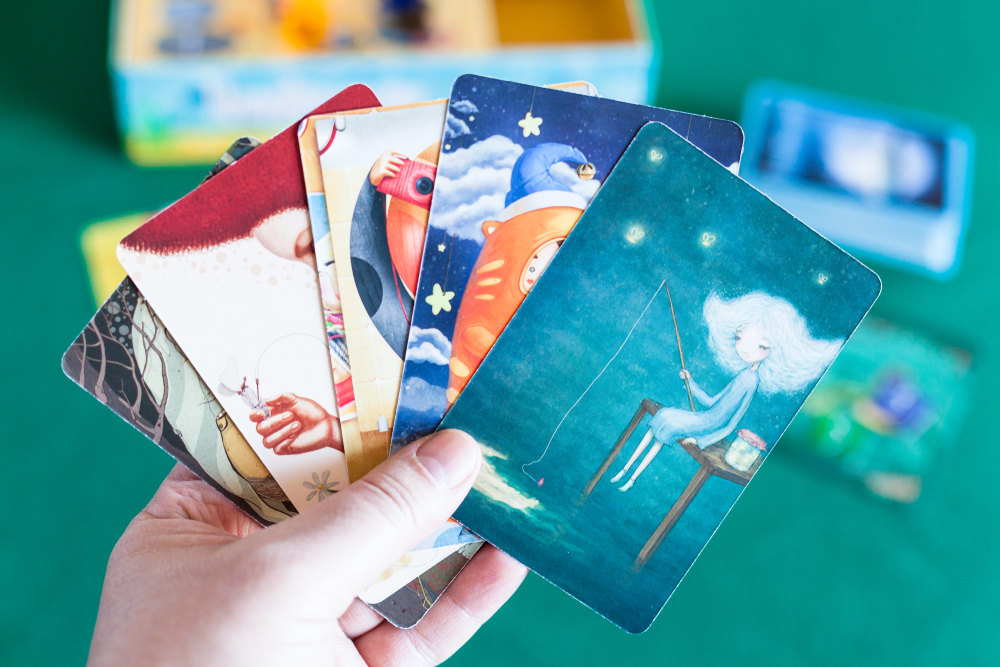- How to play Dixit?
- It was a huge success
Dixit is a card game, designed in 2008 by a French doctor, Jean Louis Roubira, who worked with young patients experiencing difficulties both inside and outside of their school environment. His ingenious creation has already helped a lot of people to improve their ability to express themselves and is a great tool in educational and therapeutic activities. Dixit means “he/she/it said” in Latin and refers to the fact this game is all about what one conceives and expresses through words during the game.
How to play Dixit?
More importantly, however, what is the purpose of the game? This is where it becomes very interesting. The players need to guess what one another have in mind. Vague, isn’t it? To put it simply, each turn one of the players becomes a storyteller. The story should originate from one of the cards in possession of that player. And, to that end, no limits are given, a player can provide a single word, an expression, a quote, a whole sentence – well, they can sing if they want to! All with the purpose of all the other players guessing the card this story is based on correctly. The cards are illustrated with somewhat surreal, dreamlike images that are meant to stimulate imagination.
However, first, the other players choose their own card to fit this story as well as possible. In the beginning, each player is dealt six random cards. The storyteller picks their card without showing it to anyone else. The rest also pick one card they think is best associated with the story, and everyone secretly passes the chosen card to the storyteller. Now, the game really begins. The cards are shown to all players, having been previously shuffled by the storyteller. And the players try to pinpoint the card the story is based on.

What are scoring rules?
In general, players are given points if they find the card picked by the storyteller. However, if no one is able to guess which it is, they are given points as well (with the assumption that the association between the original card and the story is too vague or too elaborate and therefore not possible to be guessed). Originally, 2 points were allocated to the players if all of them or none of them guessed correctly, and 0 points were given to the storyteller. If some players selected the right card, both they and the storyteller were awarded 3 points, with the remaining players denied any points.
The rules were revised after publication. A new rule was introduced, to award any player with 1 additional bonus point if their card was voted for. This way, each player is rewarded for picking a card that matches the story given by the storyteller. This is an incentive for all players to be deliberate in picking the cards they are going to show.
It was a huge success
The game was very well received. Many buyers appreciated the concept and suggested the game works well with older children, encouraging them to use their imagination. Some opinions emphasised that “the artwork is subject to a lot of interpretation” which clearly shows there are many ways to play the game and to tell stories. You might also see, if looking through some reviews, that it “requires you to look at a card and find a way to describe the image without literally spelling it out”. To this end, you need players who are keen to form some ideas of their own, as everyone takes turns to be a storyteller. Also, while picking a card to match the story you need to grasp some basic concepts, at least, as it may give you additional points if other players vote for your card.
However, some customers indicate the game is not for younger children (up to the age of 8, more or less). The cards contain somewhat “morbid, creepy or weird images”, as one review puts it, and therefore may disturb younger players. This is quite subjective, of course, and you can find these pictures in some reviews on the e-stores where the game is being sold to form an opinion of your own. The artwork is nevertheless beautiful, and everyone should at least consider buying the game as it has already proven to be a vehicle for improving people’s imagination and expression skills. Dixit!








































